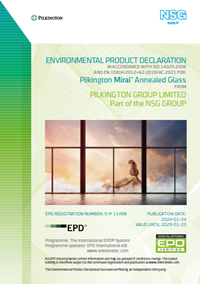Pilkington Mirai™ architectural glass manufactured by the NSG Group, has been independently verified as having 52% less embodied carbon, certifying it as the lowest carbon glass of its kind.
The independent verification comes from a new Environmental Product Declaration (EPD) now available for Pilkington Mirai™, which was launched in October last year.
The glass was developed following a series of world-first proof-of-concept trials of alternative fuels in glassmaking by the NSG Group. The pioneering trials were completed as the group works towards its Science Based Targets Initiative (SBTi) certified target of achieving carbon neutrality by 2050.
Pilkington Mirai™ has 52% less total embodied carbon when compared to standard float glass produced by the NSG Group. The glass offers the lowest carbon alternative to regular float glass on the market, with no difference in performance, quality, or aesthetic appearance. It represents a simple solution for architects, developers and asset owners to lower the upfront embodied carbon of buildings.
Kristian Chalmers, Global Strategic Commercial Manager in Architectural Glass SBU, said: “Verification of Pilkington Mirai™ as the lowest carbon glass of its kind represents a major step forward for the built environment on its journey towards a new era of low embodied carbon buildings.
“The glass enables building designers to immediately improve the carbon impact of their projects, while still offering the same attributes and performance expected from regular architectural glass. The EPDs for Pilkington Mirai™ and our broader portfolio, offers architects, developers and asset owners glass that will be transformational in helping them to achieve their carbon objectives.”
 Along with other environmental indicators, EPDs provide data about the global warming potential (GWP) of products by assessing the carbon emitted at each stage of a product’s lifecycle. Manufacturing and transport, emissions generated while the product is in use, and the disposal of the glass at the end of its lifespan are all evaluated and reported in the EPD.
Along with other environmental indicators, EPDs provide data about the global warming potential (GWP) of products by assessing the carbon emitted at each stage of a product’s lifecycle. Manufacturing and transport, emissions generated while the product is in use, and the disposal of the glass at the end of its lifespan are all evaluated and reported in the EPD.
EPDs not only empower architects and specifiers to make more informed, environmentally conscious decisions when purchasing materials but also to calculate a building’s embodied carbon.
This allows architects to have their project certified to demonstrate it meets certain standards in sustainable building design, such as LEED or BREEAM certification.
Leopoldo Castiella, Head of Architectural Glass Global, at the NSG Group, said: “The name Mirai, meaning 'future' in Japanese, was chosen to mark the start of the next generation of low carbon glass products. And Pilkington Mirai™ is a sign of the glass industry’s continued progress towards decarbonisation for the benefit of the broader built environment.
“Our mission is to continue pioneering low embodied carbon glass technology - guided by our SBTI certified targets towards net-zero, and by working closely in collaboration with innovative industry partners.”
The EPD for Pilkington Mirai™ joins 21 additional EPDs already available for the NSG Group product ranges, including float, coated, laminated and toughened glass varieties as well as Insulating Glass Unit combinations.
All of the NSG Group’s EPDs have been prepared by sustainability consultant EuGeos and independently verified by a third party, Studio Fieschi & soci.